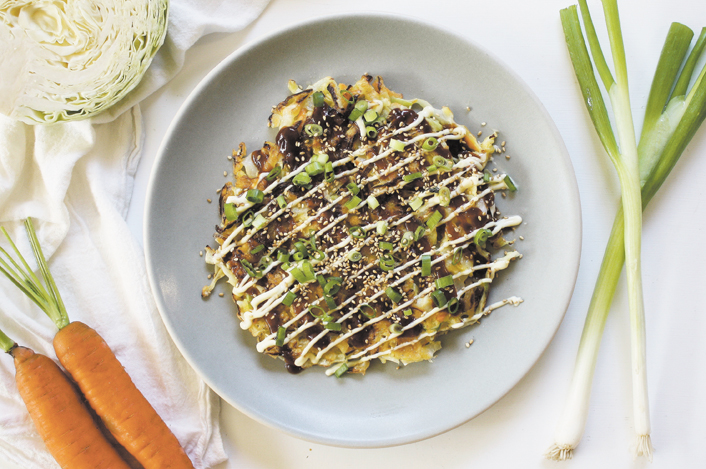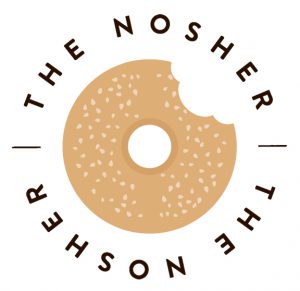Japanese-Style Latkes for Chanukah

By Sonya Sanford, The Nosher
The Japanese word okonomiyaki is derived from two words: okonomi, “how you like it,” and yaki, “grill.” Okonomiyaki is a customizable Japanese savory vegetable pancake. Like a latke, it gets cooked in oil in a fritter formation. Unlike a latke, it’s usually made into a large plate-sized pancake comprising mainly cabbage.
Food historians have linked the rise in popularity of okonomiyaki in Japan to World War II, when rice was more scarce and this recipe offered a filling meal or snack with a wheat-based starch.
Throughout Japan there are regional differences and countless variations of okonomiyaki, but the most common form of the dish involves a batter made of flour, a variety of mountain yam, eggs, shredded cabbage, green onion, dashi, and often the addition of pork belly. It gets topped with its own tangy sweet sauce, Japanese mayonnaise and bonito flakes (katsuobushi).
 The cabbage gets slightly crisp, tender and sweet when seared in oil on a flattop or skillet, and then it gets generously slathered with an umami-rich sauce, along with a welcome drizzle of creamy mayo. The richness, sweetness and tanginess of these components all work perfectly together.
The cabbage gets slightly crisp, tender and sweet when seared in oil on a flattop or skillet, and then it gets generously slathered with an umami-rich sauce, along with a welcome drizzle of creamy mayo. The richness, sweetness and tanginess of these components all work perfectly together.
I set out to modify the classic Japanese version for a recipe that didn’t require access to a specialty food store and could be made with kosher ingredients.
Full disclosure: My version lacks authenticity. If you’re going for the real deal, you’ll need a batter made with an okonomiyaki flour mix or nagaimo yam. This special kind of yam is added in powdered form to the flour mix or is grated fresh into the batter. The toppings should include bonito flakes, and the batter should be made with dashi. These ingredients can be found at most
Japanese markets. Instead of nagaimo yam, my version uses a batter of flour and potato starch, and instead of dashi I use water.
I’ve also included a recipe for homemade traditional okonomiyaki sauce that can be made with easy-to-find ingredients, but you can also buy a pre-made bottled sauce. You can make these pancakes large and cut into wedges like the Japanese do, or slightly smaller, like a large latke. I wouldn’t go too small, as the vegetables tend to hold together better en masse.
This recipe doesn’t need to be too exact, and it works as a blank canvas for additional vegetables like kale, mushrooms and/or daikon. In the spirit of Chanukah, these okonomiyaki get cooked in oil, but aren’t heavily fried. The oil used to fry the okonomiyaki is a nod to the miracle of the oil lasting in the Temple for eight days instead of one, and a nutritious, satisfying addition to any Chanukah meal.
For the pancakes:
3/4 cup all-purpose flour or gluten free all-purpose mix
1/4 cup potato starch or cornstarch
1 tsp. baking powder
1 tsp. kosher salt
2 large eggs
1/2 to 3/4 cup water
1/2 shredded green cabbage, about 41/2 packed cups
3 green onions, sliced thin, plus more for garnish if desired
1 carrot, peeled and shredded
4-5 inches daikon, peeled and shredded (optional)
Oil as needed (i.e. sunflower, canola or peanut)
Sesame seeds, for topping (optional)
Mayonnaise, for topping (optional)
For the okonomiyaki sauce:
1/2 cup ketchup
1/4 cup Worcestershire sauce
2 Tbsp. soy sauce
2 Tbsp. honey or agave syrup, or to taste
1. Start by making the batter. Whisk together the flour, starch, baking powder and salt in a large bowl.
2. In a separate bowl, beat the eggs. Add the eggs and 1/2 cup of water to the flour mixture. Whisk until smooth. You want a fairly thin, crepe batter-like consistency. If you find it too thick, add another 1/4 cup of water. Try not to over-mix; you do not want to overdevelop the gluten. Allow the batter to rest in the fridge for 30 minutes to an hour.
3. While the batter is resting, prepare the vegetables. Remove the thick core from the cabbage half, then cut the halved cabbage in two. Thinly slice or shred the cabbage. Thinly slice the green onions. Grate the carrot and daikon if using.
4. Make the okonomiyaki sauce: Combine the ketchup, Worcestershire, soy sauce and honey/agave in a bowl. Taste and adjust to your liking. The sauce should be tangy, savory, and a little sweet.
5. Combine the batter with the vegetable mixture.
6. Heat a cast-iron skillet or a nonstick skillet with about three tablespoons of oil over high heat. Once the oil is glistening and hot, lower the heat to medium low and add some of the cabbage mixture to the pan, gently nudging it into a circle shape.
I like to make each pancake with about two cups of the mixture. For me, that makes an ideal-sized pancake that isn’t too hard to flip and one that will hold together. Cover the skillet with a lid for three to four minutes. Carefully flip over the pancake, and cover it with a lid for an additional three to four minutes, or until browned on both sides and cooked through. Make sure not to cook on too high of a heat or the pancake might burn on the outside while remaining raw in the center.
7. Serve hot topped with a generous spread of the okonomiyaki sauce, mayo if desired, sliced green onions, and sesame seeds.
8. Slice and serve.
Sonya Sanford is a chef, food stylist, and writer in Los Angeles who specializes in modern Jewish cooking.
To read the complete December 2018 Dayton Jewish Observer, click here.

